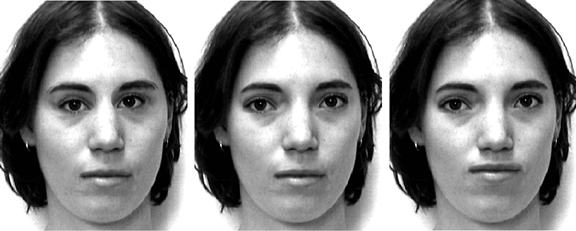Our laboratory has studied a variety of perceptual phenomena in patients with cerebral lesions. These include studies on motion perception, blindsight, neglect, and alexia, for example. Our major focus at present and for the last five years, though, has been on faces.
Face identification is one of the most challenging tasks our perceptual system faces. All faces share a fairly constrained basic shape, and only subtle variations in the precise metrical properties distinguish one from another. Despite this, we identify each other with ease on a daily basis, often with a single glance, sometimes after long periods of separation. Understanding how we do this can give us insights into the workings of the most sophisticated levels of object recognition.

One classic approach to studying face recognition mechanisms is to use the paradigm of the inverted face. Current thinking suggests that our ability to distinguish one face from another is acquired through years of exposure and interest in early childhood. Because the vast majority of the faces we see during this 'training' period are upright, the expertise we gain is orientation-specific. As a result, contrasting the perceptual skills available during processing of upright faces with those during processing of inverted faces should reveal something about the nature of expert face processing mechanisms.
A neuropsychological approach can also provide vital data. Prosopagnosia is a rare condition in which there is a fairly selective absence of the ability to recognize faces. There are developmental forms, in which subjects have a lifelong, sometimes inherited failure of face recognition, and acquired forms, in which subjects lose face recognition because of strokes, head injuries, or tumours. Our laboratory has been engaged in describing the perceptual deficits in a series of prosopagnosic patients, in particular those with lesions involving the fusiform face area. (This is a face processing region on the inferior surface of the brain, identified from functional magnetic resonance imaging studies.) We have used perceptual and imagery tests to make correlations between structural damage and functional deficits within these prosopagnosic study group.
While prosopagnosia is a rare syndrome, the data from these patients are also relevant to other conditions. For example, it has been hypothesized that there may be a link between impaired face perception and social developmental disorders such as autism and Asperger disorder. Some suggest that impaired face perception may impede the developmental of normal social interactions. Others suggest that socially impaired individuals may lack the normal interest in faces that promotes development of perceptual expertise with faces. Our early investigations of subjects with social developmental disorders show perceptual heterogeneity. Some subjects clearly have no problem recognizing faces, while others do...yet in general these subjects are not as badly impaired in face recognition as prosopagnosic patients. This raises a lot of questions. Do those with perceptual dysfunction have a fundamentally different disorder than those who do not? If so, what does this mean for genetic and therapeutic studies of these patients?
Eye movements are an elegant way to study how we interact with our environment. They are simple in their mechanics and can be precisely measured in both space and time by inexpensive devices. Conceptually, our understanding of ocular motor circuitry in animal models is more advanced than that of other response systems. Also, for most of us the exploration of the world is primarily a visual one. Understanding eye movements helps us understand human experience.
We can study eye movements for different reasons and at different neural levels, rangin from muscle to brain. Our laboratory focuses on cerebral and cognitive aspects of ocular motor function.
We are interested in what saccades tell us about voluntary control. We study prosaccades (look at a target that appears off to one side) and antisaccades (do the un-natural thing, look in the other direction). When these are mixed together in the same block, we can study 'historical' effects. What sorts of influence do prior trials have on future ones? What are the behavioural signatures of the various cognitive processes involved in manufacturing different sequences of trials? Saccades are a simple yet precise tool that can isolate the contributions of processes such as set prediction, active reconfiguration processes, and plastic changes in the saccadic system that persist from one trial to the next.
In addition to studying these in healthy subjects, we are using the same paradigms to learn about response control in schizophrenia. In collaboration with Dara Manoach at Massachusetts General Hospital, we are using fMRI and MEG to study the human physiology and anatomy of these processes.
The fovea has the finest spatial resolution of our visual map. To perceive visual detail, we need to place the fovea accurately on a region of interest. When we look at objects and scenes, we characteristically make a series of saccades that shift our fixations to different locations of the stimulus. These saccades and fixations take time and effort, but are probably important elements of a dynamic, interactive process that formulates perceptual hypotheses and aims at a threshold that will trigger a perceptual decision. To understand scanning patterns one has to understand not only the stimulus but the goal of the observer approaching the stimulus. We can examine scanning patterns for a number of observer effects. How does the type of task influence scanning patterns, even for identical stimuli? What about perceptual expertise - does historically-acquired skill in making perceptual distinctions translate to more efficient scanning patterns for information gathering? How does prior exposure alter scanning patterns, and what does this tell us about internal representations of objects? What happens when you lose this expertise, as in subjects with prosopagnosia or general visual agnosia?
We gratefully acknowledge the support of our research by the following organizations: